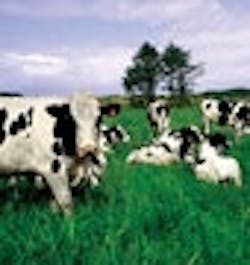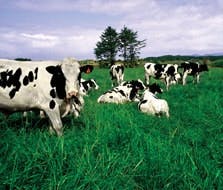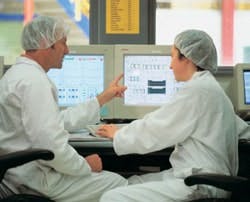Outstanding in Their Field
By Walt Boyes, editor in chief
Fonterra Cooperative Dairies, owned by over 11,000 New Zealand dairy farmers, is the worlds leading exporter of dairy products, and one of the top six dairy companies in the world. Annual revenues are in excess of US $9 billion, making Fonterra a large-scale enterprise by any measure. In North America, the co-op is better known as DairiConceptsa joint venture between the Dairy Farmers of America, the worlds largest cooperative dairy and Fonterra.
We compete in a global market, says Alice Baucke, advanced process control team lead for Fonterra. We produce the majority of our products here in New Zealand and export them offshore, so for us to be able to compete in that market, we needed to be able to take advantage of any gains we can find in productivity or efficiency.
Fonterra was formed by a merger of several different New Zealand cooperatives, uniting over 25 production facilities and numerous other plants operated by Fonterras joint ventures around the world.
So how many different basic process control systems does Fonterra have?
Many, Baucke says. You name it, and weve probably got an installation of it somewhere.
Fonterra created its own company-wide data historian. We took a company-wide approach to the method we use to collect data from our plants, so we were aided by that, Baucke says. We wouldnt have been able to do advanced process control projects on many of the sites we have if we hadnt adopted that standard architecture.
When we first started doing projects, a lot of time needed to be spent getting up to speed with the sorts of integration that needed to be done.
The first area Fonterra looked at was improving the operating efficiency of existing evaporators and dryers. If the desired efficiency improvements could be obtained, Fonterras engineers theorized, the cooperative could defer significant capital investments in new equipment and facilities.
We were able to reduce the variability of evaporator density by up to 50%, Baucke reports. Basically, if you can remove the variation in your total solids coming out of your evaporator, that means you can reduce the variation in the moisture coming off your dryer, because thats a direct feed. By removing variation in your moisture, you can push your moisture content closer to your spec limits without going out of spec, and thats where the dollars come from.
Fonterra got cash benefits from both reducing energy costs and variability.
In 1995, Fonterra began deploying Pavilion Technologies advanced process control solutions, and in 2002 began a New Zealand-wide rollout of Process Perfecter software.
Moo to You
Fonterra is the sixth largest dairy producer in the world, with most of its production coming from over 11,000 cooperative owners in New Zealand.
One of the most important lessons we learned from the first project is the importance of having a really good low-level control structure. Having an obedient plant is a prerequisite to implementing any kind of advanced process control really, Baucke says.
Among the other things Bauckes team learned was the importance of involving plant staff from very early in the project. Also we learned about the improvements that can occur from just a little bit of focus, she said.
In April 2003, an audit found that the APC solution in Fonterras first project had continued to reduce variability in total solids (TS). By 2003, the solution had exceeded the goal of 50% reduction, with a reduction of TS variation by approximately 73% for Evaporator 1 and 68% for Evaporator 2.
In real terms, a 0.5% increase in total solids from the evaporators can lead to a 2% increase in dryer throughput.
- Fonterra reports a higher than 60% ROI for its deployment of APC, with global benefits, including:
- increased production rates of 5-15%,
- improved product quality by 50%,
- reduced variability on all key control variables,
- increased energy efficiency by 5-12%,
- increased product yields.
Involving Operations Staff
Fonterra APC engineers involve operations staff very early in new projects for greater chance of continued success.
Baucke continues, For example, weve got plant managers out there who have advanced process control systems in their plants. What theyre interested in knowing about is how their factorys bottom line is improved by running APC. Whereas, the APC engineers on our team in their office want to know how often APC is being used or some of the internal model frameworks for APC. So it has been a consultative and iterative process to decide what information we share with what people.
Yeah, it has taken time, but we think were getting there now, Baucke concludes.
With the large number of disparate systems Fonterra has globally, it made sense to roll out a single solution worldwide. It just made business sense, Baucke says, for us to try to make the same sorts of gains that wed received from our first project across the entire business. We conducted an internal benefit assessment to try to identify some potential opportunities, and then we calculated the potential value to us if we took an enterprise-wide approach. With the sort of return that we were looking at and the confidence that we had attained in the technology, it was a pretty simple decision really, Baucke says.
The Pavilion 8 solution scales well, Baucke reports. It gives us both horizontal and vertical scaleability. Weve used Pavilion 8 in some of our more diverse businesses. Were using it in our canning operation for reporting and in our ethanol business, but also in the dairy ingredients stuff.
One of Fonterras major corporate objectives is to reduce its environmental footprint both in New Zealand and worldwide. Baucke says, Were also using Pavilion 8 to monitor our wastewater treatment and discharge, so were making sure were complying with our local government regulations.
How deep does APC run at Fonterra? Baucke reports that the company has over 100 Pavilion APC applications online and operating. In our dairy ingredients business we use them to improve unit operations, such as evaporation, drying, energy and standardization.
Were upgrading to Pavilion 8 globally, and were partway through applying Pavilion 8 to one of our ethanol facilities. In two of our plants were using Pavilion 8 to monitor environmental discharge in real time, so we can minimize our impact on the streams and rivers around our facilities, and also make business decisions on reducing discharges. Were evaluating rolling out this application to all of our facilities in New Zealand.
Hear the Story
To hear a podcast interview with Fonterras Alice Baucke, visit http://www.controlglobal.com/articles/2007/265.html. Walt Boyes asks questions about Fonterra, Advanced Process Control, Pavilion Technologies, and the bottom line.



